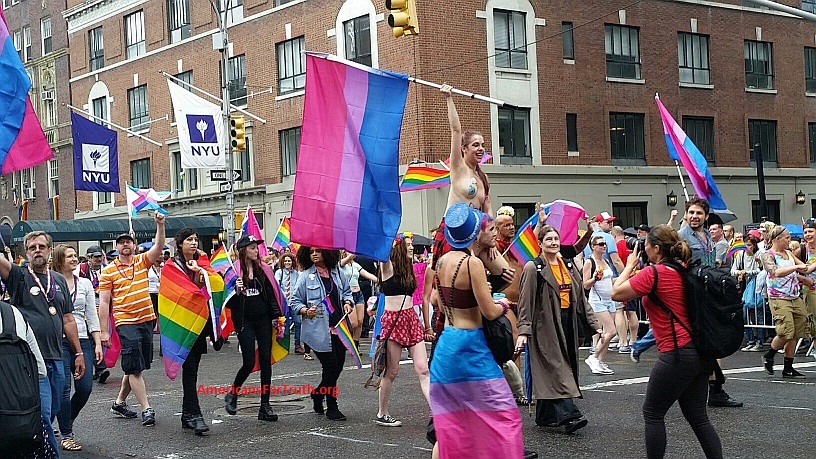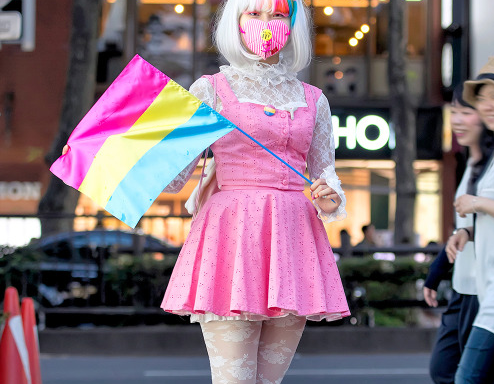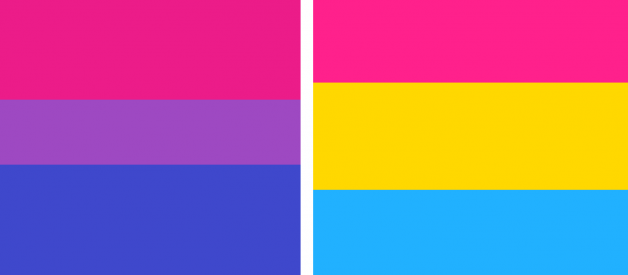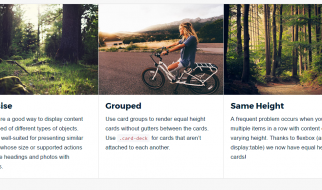Multiple-Gender-Attracted identities and the differences and similitudes between them.
 Image: the Bisexual flag on the left and the Pansexual flag on the right.
Image: the Bisexual flag on the left and the Pansexual flag on the right.
It seems like every day there is someone, somewhere, arguing that either bisexuality or pansexuality are either ?made up?, ?pretentious?, ?transphobic?, or even a direct attack on the other identity?s existence. When these discussions arise, we?ve always swarmed with cissexist, binarist and transphobic definitions of both sexualities, as well as ?dictionary definitions? that are ahistorical and disrespectful. This article aims to be a short, catch-all explanation of these two identities and their histories.
Pansexuality and bisexuality are two sexual orientations that describe the experiences of people who are attracted to multiple genders (MGA). They are not the only existing labels for MGA, but they are the two most well known in Western cultures.
Bisexuality
 Image: people holding up in bisexual pride flags at NYC Pride parade.
Image: people holding up in bisexual pride flags at NYC Pride parade.
The word ?bisexuality? was first used in 1892 in the ?Psychopathia Sexualis?, a book that treated same-gender attraction as a psychiatric deviation. Like the word ?homosexuality?, this word was used to pathologize and oppress people who experience SGA and MGA. Sometime in the 60?s, what would become the USAmerican LGBT rights movement adopted the ?B? and reclaimed the term.
While the original word (as coined by a cisheterosexual psychiatrist who thought of MGA people as deviants) meant ?attracted to [cis] men and women?, it has since been reclaimed and re-defined by different bisexual organizations.
The two most popular definitions today are ?attracted to one?s gender and to different genders?, and ?attracted to more than one gender?. The definition of bisexuality as ?binary? or ?attracted to both men and women? is dated and ahistorical, and no longer accepted by the bisexual community.
Pansexuality
 Image: one person holding a pansexual pride flag and wearing a pansexual pride pin at Tokyo Pride parade.
Image: one person holding a pansexual pride flag and wearing a pansexual pride pin at Tokyo Pride parade.
Like ?bisexuality?, ?pansexuality? was coined by a psychiatrist, and its original meaning was vastly different from what it is today. It was used by Freud in the early 1900s, but it referred to the way people felt their attraction rather than whether they were attracted to multiple genders or not.
The word was reclaimed in the early 90?s, and its since been (pretty much universally) defined as ?attraction regardless of gender?.
It shouldn?t be defined as ?attracted to trans and cis people? (as this is transphobic) or ?attracted to hearts not parts? (as this is also transphobic, cissexist and dyadist) or ?regardless of biological sex? (as biological sex is a transphobic and dyadist concept). Pansexual people are attracted to people regardless of gender, not genitalia; just like gay people are attracted to people of their same gender, not of their same genitalia.
Similitudes and differences
 Image: a heart-shaped pansexuality pin and a flag-shaped bisexuality pin.
Image: a heart-shaped pansexuality pin and a flag-shaped bisexuality pin.
Bisexuality and pansexuality are often overlapping, but not identical identities. For some people they might feel like the same thing, and there are even a lot of people who identify as ?bi/pan?, as it is indistinct for them which label is used to describe them. For others, there is a world of difference.
As pansexuality means attraction ?regardless? of gender, pansexual people usually feel equally attracted to any gender and their experience of attraction doesn?t vary no matter what gender the person they are interested in is.
For some bisexual people, gender is also irrelevant to their attraction. Other bisexual people are, for example, only attracted to their same gender and non-binary people, or more attracted to one gender than other, or look for different things in their relationships with people of different genders.
Some people will choose one identity over the other because they feel it better describes their experience, because they feel more connected to its history or even because they like the word better. All experiences of pansexuality and bisexuality are valid.
What?s important to remember is that neither sexuality is inherently binarist, transphobic or dyadist; and that there are trans and/or non-binary people of all sexual orientations, and that the only people who are ?exclusively attracted? to cis people are transphobes.


